With our early posts on Wild Lot, we thought we could attempt to illustrate our personal interest in the topics we hope to explore on this blog, namely, the role natural setting plays in forming and inspiring creative writers, and how our favorite authors, in recognition that we, through our fragile civilization, are only one small and superficial step removed from being wild ourselves, often use nature as an apt symbol for humanity. So, in the spirit of this, my first post will be a bit autobiographical…

I was in a creative writing class my first semester at the University of Pittsburgh, early 2000s. We each had to bring in a short story that was important to us as fledgling writers. I don’t remember what I brought in. But one student (Jared, I think?) brought in a photocopied excerpt of Polish author, Bruno Schulz’s Street of Crocodiles/Cinnamon Shops entitled “Pan.”
The University of Pittsburgh has a deep-seated connection to Central and Eastern European culture, due to its location–a steel town originally comprised of immigrant workers and, now, their legacy–which is likely how the student in my class was exposed to Schulz, and one of the reasons I wanted to study there. My mother grew up in East Germany under Russian rule, and her family lost their farm, and the greenhouses that she was to inherit as a training horticulturist, to the Soviet’s communal agriculture programs. Her family was also of Sorbish origin, a tiny pocket of slavs, with their own language and customs, living in Germany near today’s Czech and Polish borders. In hindsight, I think my burgeoning interest in slavic studies was an attempt to keep one foot at home, as I advanced, awkwardly and confusedly, into adulthood. Schulz soon became one of my favorite authors, and my senior thesis embarrassingly reads like an homage to his writing. However, when reading “Pan” the first time, in my first semester, I was wildly unaware of all of the cultural nuances and connections of his work, flying right below the surface. The majority of Schulz’s work was written between World War I and II, in the heart of Eastern Europe, looking back on his childhood, a time of relative prosperity and stability, while his final work was written under Soviet Occupation, and lost to the ages after his death in 1939 at the hands of a Nazi soldier. Even his conspicuously germanic name did not register to me at the time. And I was also completely oblivious to the fact that the story was, funnily enough, a symbolic parallel to my own bumbling experiences coming of age, as an introverted, nervous, and somewhat repressed late adolescent.
What first spoke to me, in reading “Pan,” was the subject–a beautifully detailed, heralded, mythos-infused…vacant lot.
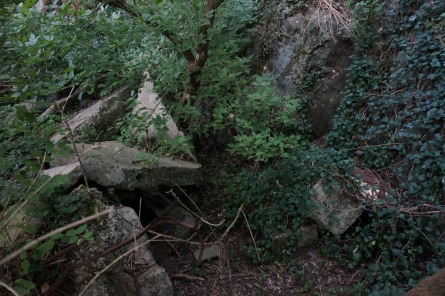
As a kid, I spent summers at my parents’ car repair shop, located next to a very large abandoned swimming pool. There was an expansive gravel parking lot consumed with weeds, the perfect place to circle in an old bicycle, a shady road that led back to a small abandoned quarry, remnants of amusement rides rusting just out of sight in the feral ivy, swathes of fiery day lilies and burn hazel along the banks of the Little Conestoga Creek, behemoth hollowed-out silver maples surrounded by their own broken branches, and behind a caving chainlink fence, the basin of the old pool, the central foundation of its infamous swings ride now serving as an island for vegetation–tall grasses, white and yellow sweet clover, purple loosestrife, the occasional maple sapling. I picked bouquets of yellow and orange snap dragons that bloomed in profusion under one of the maples, lilies, and chickory and queen anne’s lace, whose fibrous stems would only break with much twisting and pulling. I built bridges of bricks and cinder blocks through the shallow mucky water in the bottom of the drained pool, led turtle hunts with the family dog, a lanky weimeraner named Smokey, and later, when the site was being reclaimed as a park, waded in the waist-deep mud pits, some unknown byproduct of construction, before trudging back to the shop to be sprayed clean by the car wash hose. Exploring this place is one of my favorite memories of childhood, of which my college years became both a tail and a bridge. So it was with these eyes that I first read “Pan.”
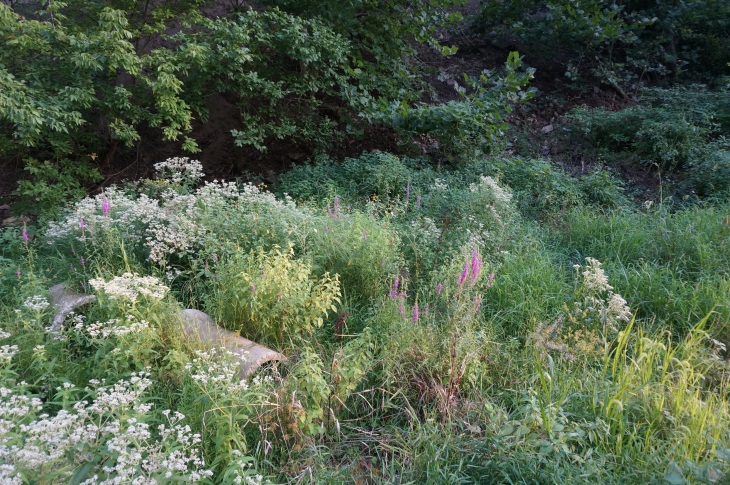
In synopsis, “Pan” is a vignette where Schulz, as a young boy, breaks into a “great and savage old garden,” wanders around, exploring and observing in awe, as he likes to do, and in the midst of his reverie, stumbles upon a hobo….
Pan, in Greek mythology, is the god of the wild, has the horns and hindquarters of a goat, and resides in Arcadia, a mountainous region. Schulz’s Pan is the underscore of the story itself, which is one of a child losing himself in a tiny pocket of natural solitude that has been permitted to grow off an alley in an otherwise urban setting. A once-productive garden, it is now an abandoned space that is brimming with a new stage of chaotic growth.
As with any wonderland, the protagonist first must breach the wall, and he, with unnamed accomplices, pries away a fence board and slips in, “released into a new, airy and immense world.” The space is thus clearly defined and bound, yet becomes expansive upon entry. It is not only expansive because we are told it is (“the garden was immense; it branched with numerous pathways; it had different zones and climates…”) but because it is full–teeming.
One of my writing teachers, Samuel R. Delany, liked to draw our attention to lists in works that we read. My favorite example: an epic feast in Lost Illusions that featured as its centerpiece, the head of a real dolphin. These lists are a method of description that is efficient at establishing setting, pleasurable to read, and also, I’ve discovered, overwhelming to the reader. They leave the reader dazzled by number. Schulz, always keen on presenting a sense of wonder, utilizes this effect with enthusiasm. “Pan” is essentially a four page list of objects in the hidden garden and their details, peppered with the experience of being in the midst of them, with a little bit of the narrator’s actions to move us along, to the discovery of Pan:
Here was a great and savage old garden, where tall pear trees and spreading apple trees grew in huge, scattered clusters, sprinkled with a silvery rustle, a frothing net of whitish sparkles, and a downy sheepskin of lush and disorderly unmown grass was spread over the undulating terrain. Here was coarse meadow grass with feathery tufts of flower spikes, delicate filigrees of wild parsley and carrot, tiny, coarse and wrinkled leaves of ground ivy, blind nettles scented with mint, and fibrous, shiny plantains sprinkled with rust, erupting in sprays of thick, red gruel. All of this, tangled and downy, was imbued with the gentle air, lined with azure wind and saturated with the night. To lie down in that grass was to be canopied by the entire azure geography of the clouds, their drifting continents, and to inhale the entire, immense map of the heavens.
The effect is immersive and hypnotic.
As Schulz continues, the space buzzes, increasingly chaotic. We have left the oppressive order of the city, and, now freed, must follow the timeline of nature’s resurgence in the abandoned setting. As we proceed in space, we move in time as well, starting with domesticity gone astray in the early days of rewilding: pear and apple trees are “spreading,” wild parsley and carrot grow in the unkempt lawn. As the story progresses, we follow Schulz into the purely wild, as the first landscape elements slowly give way to their predecessors, the ecology becoming increasingly complex, until it peaks, stabilizes, in a climax community, a new order. This is known as ecological succession.
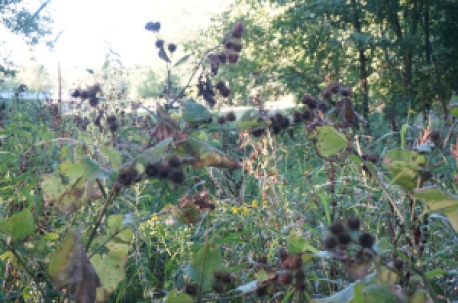
Nature can teach us much about the narrative arc.
What is striking about “Pan,” which makes it such a perfect little story, is that the movement of the plot is supplemented and intensified by the natural progression of the landscape. It moves slowly from the safe and domestic city alley to the wild. In fact, even Schulz’s language, discussing the “zones and climates” of the garden, mirror permaculture terminology. In permaculture design, which combines logical usage with natural setting, you keep the areas that you access daily, the domestic sphere, close to the domicile (Zone 0). The zones spread out from there in order of human usage, utilizing microclimates in their design–a sunny wall, a swampy ditch–until, far down the winding paths of the garden, you may find the rare Zone 5, the purely wild zone. Schulz writes:
…the further it sank down one of its long pathways, the more emphatically dark it grew until it immersed in shadow by the back wall of a disused soda factory; the more gruff and nonchalant it became, running wildly and unkemptly to seed, rampant with nettles, bristling with musk thistles and scabbed over with weeds of all kinds, until at last, in a wide, rectangular recess between the walls, it lost all restraint whatsoever and flew into a frenzy.
Here we meet Schulz’s microwilderness. We might expect that this is the moment of sublimation, where we are thrown into the beautiful symphonic chaos of nature and so arrives the mythological god of the wild and for one brief and shining moment we witness the miracle of immortal divine existence. But no. Schulz is too modest, too fatalistic for that. The vantage point of the child is not about embracing naivete, but frankly illustrating, as the punch line, how it is lost. This is what makes his work so poignant, and also, so artfully comedic.
The wilderness he presents is one that puts the modus operandi of all life, flora and fauna alike, in the forefront: reproduction. It culminates, so to speak, in a more animal ecstasy, a garden of “licentiousness.”
Vacant, savage cabbage heads of burdocks held sway there, bestial and giving reign to their passion, enormous witches divesting themselves of their huge skirts in broad daylight, casting them off, skirt after skirt, until that whole quarrelsome bastard tribe was buried under its own swollen and rustling, torn and crazily patched rags.
Innocent boy Schulz, literally chasing butterflies (“I was at that hour seized by an ardour for catching butterflies…”), stumbles upon his Pan.
There are many variations of Pan. But he is rarely depicted, in art, without a phallus. A careless reader (as I was, years ago) may have skimmed through the sexually-charged burdocks and orchards and chocked it up to purple prose, and perhaps it is, but these descriptions, like the pink ribbons in “Young Goodman Brown,” are a critical and deliberate setting detail.
Despite being half-goat, Pan is possibly the most human of greek gods. He is a mortal, one of only two gods that dies. He falls in love and is scorned on more than one occasion. And it is his thwarted attempts at romance that lead his father, Hermes, to teach him, rather than destroy the nymph who rejects his advances, the bodily release for his frustrations: masturbation. Which, as legend has it, was a trick he went on to share with all the young shepherd boys.
So, let’s return to Schulz’s orchard, which is described as, by the end of the garden path “merely a paroxysm of frenziedness.”
Pan first is mentioned, paragraphs before his actual appearance, at the beginning of a rattling chain of description of the characteristics of time in the middle of a hot summer day: “a moment when time, crazy and wild, breaks loose from the treadmill of events and runs shrieking, cutting across fields like fugitive vagrant [sic]… [growing] into some other, degenerate time, into an unknown dimension, into mania.” Young Schulz runs to the edge of the burdock patch, stopping short, “not daring to plunge into that silent hollow,” (“silent hollow”!) as if he is standing on the cusp of some temporal portal. And in that hollow, “immersed shoulder high in burdocks,” those symbolic weeds, is Pan.
He sat lurking, as if ready to pounce, his shoulders hunched as if by some great weight. His body heaved with exertion, and sweat poured from his cupreous face, shiny in the sunshine. Without moving, he appeared to be hard at work, wrestling on the spot of some enormous burden.
I stood transfixed by his gaze, which held me tightly in its grip.
When I first read this story, I was not only blissfully unaware of the cultural climate of Schulz’s world, but I also had no idea what exactly this bum was doing. As I mentioned before, I enjoyed young Schulz’s reverie, it reminded me of my own childhood, pedaling my older sister’s banana seat bicycle through my own abandoned eden, complete with burdock patches. I remember being a little befuddled by the man’s presence, but assumed he was just some strange figure whose purpose was to interrupt the moment with his weirdness, and something was lost in translation. We never mentioned it in class, except a vague discussion of who the god Pan was (prompted by ever-clueless me).
To add to my gleeful obliviousness at the time, I first read Pan only months after composing a poem about a person sitting on the grass and picking a wilted dandelion, inspired by Albrecht Dürer’s Great Piece of Turf. My professor at the time asked if my poem was a double-entendre. It was not. I share this excerpt with you, in trust, that if you are a poet, you also wrote something equally embarrassing, in your youth.
Turf
Reclining in verdure,
leg traversing leg,
above branching roots and fertile earth.Reaching down to pluck the head of a spent weed from its rigid stem.
Ripping tufted bits of sheath and blade from knotted joints,
clasping, then releasing,
leaving celadon traces under white fingernails.Extracting poesia
from what is sincere.
To grasp is to possess.
The second time I read “Pan,” on my own, I still did not see the sexual overtones. The narrator found a whacky bum character crouching in the brush who then jumped up and ran away, I thought. I encountered this man at the bus stop a few times myself. The third time, after reading a blog post that suggested he was “taking a shit,” I thought “oh.” But it didn’t feel right. I finally, when first composing this post, researched the mythology of Pan myself, and the answer was in plain sight. I felt like I had solved a great mystery.
I came to know and love Schulz’s writing by reading “Pan,” although I appreciated it on only a superficial level. Each read brought me closer to its intent, but, fundamentally, even without whole appreciation, the setting is the glory of the piece–it is what makes the story work. We delight in these secret, anomalous places that hide around the edges of our civilized zones, even replicating them in urban spaces in the form of niche parks and community gardens. I’ve eaten many lunches, myself, on a quiet bench tucked behind a sheltering tree, hoping for solitude, even as the sound of mufflers and rotors hums in the near-distance. These quiet places allow us to be alone with ourselves, and what better place, what better juxtaposition, to be confronted with something jarringly alien?
Shocked to the core, I saw how he slowly drew himself up from his haunches, bellowing with laughter from his powerful breast; how, hunched like a gorilla, his hands deep in his sagging rags of trousers, he fled, splashing with great bounds through the flapping metal sheets of burdocks–pan without a flute, retreating in panic to his native woods.
I wonder, at what point, did the real child Schulz understand what he saw. Clearly not then, as author Schulz has made the description of the hobo’s movements decidedly vague. As readers we are not shown anything more than the child sees, though, as good readers, who have read much worse, who are all closeted perverts and saw the foreshadowing cues clearly and with anticipation, we understand. But what lasting effect, if any, did seeing a dirty man dressed in rags, wanking in the weeds, have on his developing sexuality? And how much it adds to the story of Schulz nervously delivering his manuscript to Zofia Nalkowska, and how wonderful that it was actually sent to press!
At the abandoned pool site there was a pathway, dusty, cutting through the hill of purple and pink crown vetch, from a bus stop on Columbia Avenue to the Stone Mill Plaza shopping center, a strip mall monstrosity with a grocery store, pharmacy, and pet store, among others. There was, and still is, a large, circular, rock-filled drainage ditch, littered with half a dozen or so abandoned shopping carts, which the path skirts. On more than one occasion I ran into an unsavory character, bearded, in disheveled clothes, always smoking, walking up or down the pathway, so that after a while I began scoping it out before I began my trek to the Rite Aid for Garfield stationary or whatever I currently coveted. Even though I could see the shop where both of my parents were working (it was maybe a fifty feet away, I was so close I could hear the phones ring), this area was a veritable no man’s land to me. I never passed through it without running. Once I even saw a snake skin in the middle of the path.
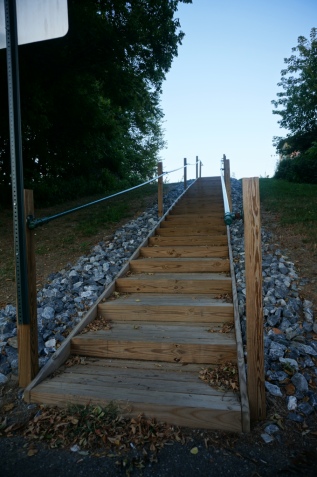
Today the path has been officialized–it now has signs, steps of treated wood, and a freshly-painted railing.
I am grateful that my parents were of a generation that let children roam. From a young age I was allowed to be alone, in vaguely scary but mostly safe places, both public and isolated, while my parents went about their lives nearby. It is aloneness that cracks us open and allows us to be most receptive to our experiences. And the false sense of safety that aloneness affords grants the opportunity for the most impactful unexpected encounter: to sometimes see the strange face-to-face as well, and not always from afar, hiding in the bushes. In stories, this confrontation is how characters often change. We read stories because we want characters to change. We covet that experience of sudden growth, we enjoy it vicariously, we wish we could metamorphosize so quickly and permanently. In “Pan,” young Schulz is caught, stunned by what interrupts his innocent reverie, and that is the moment we are left with–a boy in dismay, uncloaked, watching a bum flee to the woods–the change crystalized in time. In real life, it is not so sudden and clear. Growth is much less of a pivotal change, but rather an ongoing exposure to the slow dispersion of truth, in the form of many many small heart leaps.
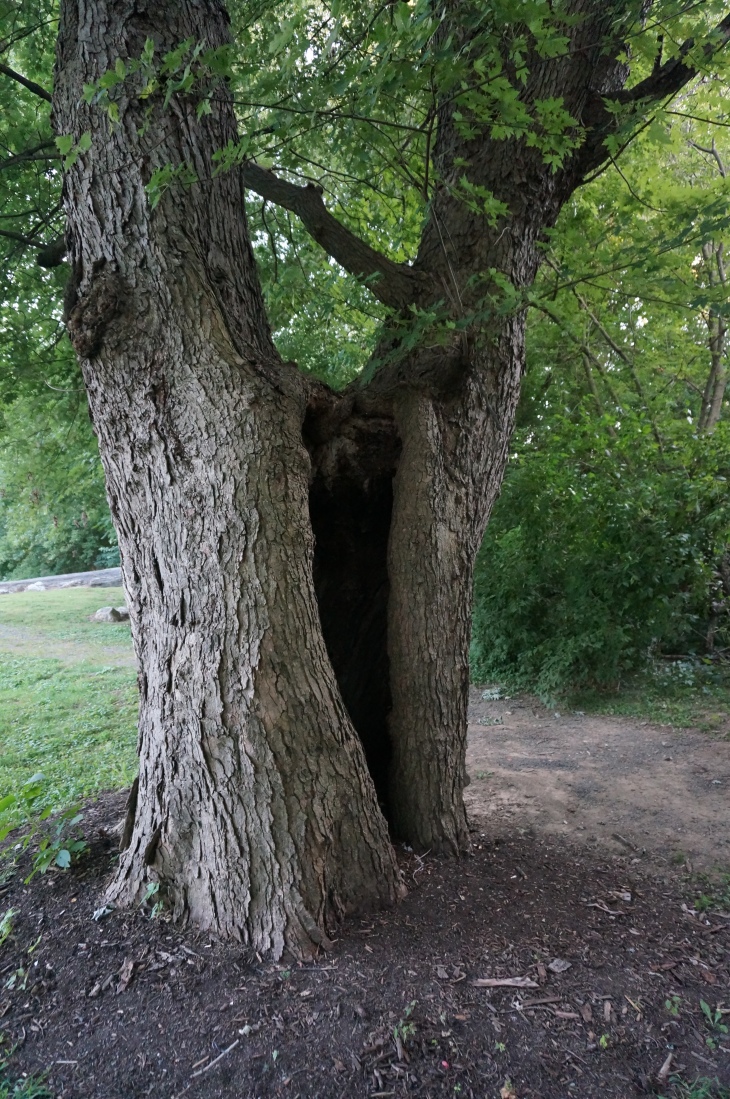


You must be logged in to post a comment.